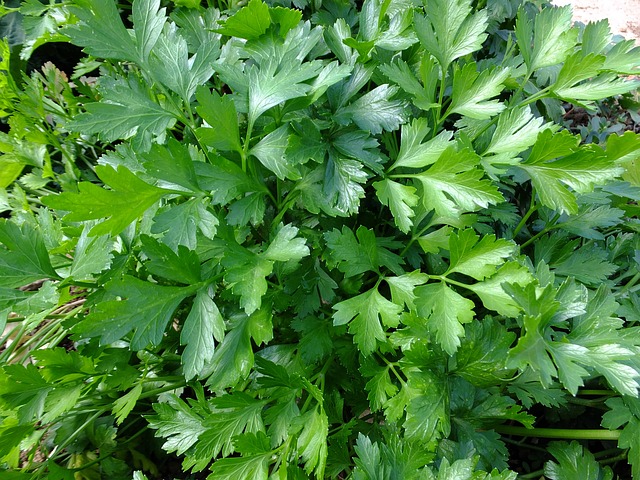 |  |  |   |   |
 |  |  |
Common garden parsley or curly parsley is a biennial plant, 50-100 cm tall, with a fleshy, yellowish-white root. In the first year, the plant forms only a rosette of leaves. In the second year, strongly branched stems with a stem are formed. Flowers small, white. Blooms in June-July. Fruit, a small greenish-brown, slightly flattened dicotyledon.
We have several types of parsley, some are grown for the leaves, others for the roots. Leaves and roots are usually used in food, while seeds are more often used in medicine.
Root parsley is harvested in autumn, necessarily before frost, the leaves are cut, the roots are stored in a cool place, covered with dry sand.
Parsley leaves contain vitamin C, luteolin, apigenin, up to 0.08% carotene. The rhizomes contain large amounts of apigenin. The flowers contain quercetin and kaempferol. Parsley fruits contain up to 22% vegetable oil, which includes flavonoids diosmin and apiin, glycosides naringenin and apigenin, glycerides of petrosic acid, as well as luteolin. The seeds contain 2-6% of essential oil, which includes apiol, coumarin, myriscin, apilic acid, alpha in acne, allyltetramethoxybenzene, vitamins A, В1, B2, B5, B6, B9, C, Е, H, K, PP. Parsley contains a large amount of iron, calcium, potassium, zinc and phosphorus.
Ārstnieciskā nozīme
Pētersīļa sakneņa un virszemes daļas ārstnieciskās īpašības, galvenokārt, saistās ar augā esošo miristicīnu un apiolu. Pētersīlis pastiprina zarnu, dzemdes gludās muskulatūras un urīnpūšļa tonusu. Pastiprina diurēzi. Palīdz dzemdes asiņošanas, sirds apvidus tūskas gadījumā un darbojas, kā urīna dzenošs līdzeklis pampuma gadījumā
Augā esošā sula ir noderīga gaisa apmaiņas procesu pastiprināšanai organismā un lai normalizētu sirds darbību. Tāpēc augs, ne tikai ir vērtīgs, kā urīndzenošs līdzeklis, bet arī lieti noderēs sirds nepietiekamības gadījumā. Vienā reizē lieto ne vairāk par vienu ēdamkaroti, pētersīļa sulu. Ideālā variantā, to ir jaukt ar burkānu sulu attiecībā 1:3.
Plašu pielietojumu atradušas ir arī pētersīļa sēklas. Tās ir labs urīna dzenošs un karminatīvs līdzeklis, turklāt ar to palīdzību var izraisīt sievietēm mēnešreizes. Sēklu novārījumu lieto mirdzaritmijas gadījumā, kad to pavada sarežģījumi, kā sirds nepietiekamība ar tūsku. Pētersīli ir lietderīgi lietot sievietēm, jo mēnešreižu laikā sievietes zaudē daudz dzels, attiecīgi, lietojot pētersīļa lapas, dzelzs līmeni var ievērojami pacelt. Pētersīlis mazinās arī sāpes, kuras ir sievietēm pirms mēnešreižu sākuma. Auga fitohormoni ir līdzīgi estrogēnam, tie palīdz sakārtot ciklu, īpaši ja mēnešreizes ir aizkavējušās.
Pētersīlis uzlabos arī ēstgribu! Īpaši, ja tā saturošu salātus, lietosiet neilgi pirms pamata maltītes. Šis augs ir arī neaizvietojams, ja vēlaties atbrīvoties no liekā svara. Auga aktīvie elementi uzlabo tauku apmaiņu un darbojas pret tauku nogulsnēšanos.
Pētersīli var lietot, arī vēdera uzpūšanās gadījumā, aknu, zarnu, urīnizvadkanālu slimību gadījumā.
Pētersīļa sēklas izmanto, lai uzlabotu gremošanu. Tās labi noder meteorisma, pārēšanās un sliktas dūšas novēršanai. Šādam nolūkam gatavo maltu sēklu uzlējumu, kuru nostādina vismaz 8h, hermētiski noslēdzamā traukā. Der arī burciņa ar vāciņu. Iegūto uzlējumu lieto 30 minūtes pirms ēšanas, pa vienai ēdamkarotei.
Tautas medicīnā pētersīļa preparātus lieto, kā spēcīgu karminatīvu, urīna dzenošu, sviedru dzenošu līdzekli. Ar to ārstē nierakmeņu un citas urīnvadu sistēmas slimības, tūsku, sirds slimību radītu tūsku, dismenoreju, kā arī lieto ar mērķi uzlabotu gremošanu.
Lapas un sakneņus var pielietot, lai ārstētu brūces. Svaiga sula labi palīdzēs čūsku kodumu un bišu dzēlienu gadījumā. Auga nostādinājumi lieliski novāc nepatīkamu smaku no mutes, to dezinficē, palīdz ārstēt smaganu slimības.
Pēc C vitamīna daudzuma pētersīlis ir tuvu līdzīgs citrusaugļiem un upenēm. Tāpēc šo augu var lietot, lai bagātinātu organismu ar C vitamīnu saaukstēšanās laikā.
Interesanti ir tas, ka pētersīlis tāpat, kā dille ir augs, kuru var dot arī maziem bērniem- pirmajā dzīves gadā. Pētersīlis palīdzēs bērna organismam absorbēt olbaltumvielas, veicinās gremošanas fermentu izdali un uzlabos žultsvadu motoriku. Bērniem no 8 mēnešu vecuma pētersīli, 3-5gr.var pievienot zupās, to iepriekš samaļot un zupā pievienojot minūti pirms gatavības. Svaigas lapiņas var dot jau vecākiem bērniem- no 1,5 gadu vecuma.
